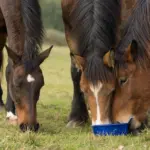Letting hay cure after harvest is a crucial step in improving its quality and shelf life.
When hay is harvested, it usually contains a certain amount of residual moisture—typically in the range of 14–18%. Curing allows this remaining moisture to be reduced, which in turn lowers the risk of mould growth and spoilage.
The curing process also helps release excess heat from the hay. After baling, there is intense microbial activity, which increases the digestibility of the hay for horses. So, overall, it’s a beneficial process.
In addition, many plant toxins are broken down during this process—for example, those from buttercup plants or grass endophytes.
However, the metabolism of these helpful bacteria also generates a significant amount of heat, which can lead to spontaneous combustion of the hay—and potentially burn down the entire barn.
It’s not just the risk of spontaneous combustion that makes proper storage of freshly harvested hay so important. If the hay gets too hot, the sugars naturally present in the plants can begin to caramelise, leading to a brownish discoloration and a slightly bitter taste in the feed. Many horses will refuse to eat such hay, even if it smells pleasantly like caramel to us.
Unfortunately, during this process, bacteria also produce ammonia, which can irritate the horse’s respiratory system. This is another reason why hay should not be fed during this phase and why proper ventilation is essential during the storage period.
If horses eat hay that hasn’t been properly cured or stored, they risk developing colic and laminitis!
It’s important to note that the curing process takes time and requires specific storage conditions. Hay should be stored on a well-ventilated surface—Euro pallets work well—in a well-aired barn or shed, allowing for proper air circulation.
The bales should not be stacked tightly together but rather with sufficient space between them to allow airflow.
The curing period varies depending on weather conditions and the type of hay but typically lasts between 6 and 12 weeks. If your fields contain a lot of high-sugar grasses, it’s best to wait the full 12 weeks, as the endophyte toxins take relatively long to break down.

© Adobe Stock/andreasbuchwald
Letting hay sweat properly and ensuring good hay quality:
To allow hay to cure correctly and achieve high-quality results, the following steps should be observed:
1. Harvest timing: Hay should be harvested during dry weather, when both air and soil moisture levels are low. The stems should snap cleanly when bent—this indicates the right stage of dryness for cutting.
2. Preparation: Before storage, the hay should be dried to an optimal moisture content of around 14–18%. To achieve this, it should first be dried and turned in the field to ensure even drying throughout.
3. Storage location: For the curing process, a well-ventilated storage area is essential—one that protects the hay from rain and moisture. A barn or shed is ideal. The space should not be completely sealed, which is why traditional barns often have slits in the walls to allow for airflow.
4. Stack size: Bales should be stacked loosely, with gaps between them and not too high, to allow for good air circulation and for heat to rise. The higher the residual moisture content, the looser the stacking should be. Once the curing process is complete, the hay can be stacked more tightly and higher to make room for additional bales.
If the round bales happen to get caught in a rain shower after harvest, they must be allowed to dry thoroughly before being stacked to prevent mould growth. To do this, they can be placed on pallets in front of the barn under the midday sun—UV light helps reduce microbial contamination, and the warmth quickly dries the outer layers.
5. Covering: If the hay needs to be stored under fleece or tarp, it should initially be stacked loosely and not completely covered at the sides to allow for proper ventilation.
6. Monitoring: Curing hay must be checked regularly to detect overheating, mould growth, unusual odours, or discoloration early on and take corrective action if needed. Even the most careful storage can’t completely rule out issues during the curing process.
The best way to monitor hay is by regularly checking it with a moisture meter—ideal readings are around 15%. For temperature control, use a hay thermometer. If temperatures between 50–55°C (122–131°F) are recorded in the first few weeks after baling, the curing process is proceeding normally. If the temperature reaches 65°C (149°F) or higher, there is an immediate risk of spontaneous combustion. In that case, the bales must be separated to allow them to cool down. If the temperature remains below 40°C (104°F), microbial activity slows down, and the hay stabilises.
Conclusion
The 6–12 week curing period is an essential part of the hay preservation process. During this time, digestibility improves, plant toxins are largely broken down, and ammonia can dissipate. Hay should never be fed during this phase—doing so can lead to colic or laminitis.
When done correctly, the curing process allows remaining moisture to escape, improving the quality and shelf life of the hay. Properly cured, dry hay is easier to store, retains more of its nutritional value, and keeps its aromatic scent—making it more appealing and palatable for horses.
Guest Author: Helmut Muss (Die gesunde Pferdeweide)
More on the topic of “hay quality”:
Artikel: Heukonservierung und Heudesinfektion
- Making hay in a rainy summer: what should you look out for? - 14. June 2024
- Soil differences and their significance for horse pasture - 31. May 2024
- Pasture care: preparing the fields for winter - 19. October 2023










